Field Investigation Report on Oil Palm Cultivated by Company K and Smallholders in Sarawak, Malaysia
Yucho Sadamichi(The National Institute of Advanced Industrial Science and Technology)
This is to report a cooperative survey with Prof. Ubukata, conducted at Company K in Sarawak on 14-21 September 2012. Company K is an oil palm plantation company with a processing mill, which is located in Bintulu, Sarawak. Since this company produces RSPO-certified oil, the company activities are implemented in accordance with RSPO requirements, e.g. compliance with environmental and social laws and regulations, fulfilling cooperative social responsibilities, etc. This certification requires the company to document the related activities. From the documents, our previous surveys obtained a variety of data such as the amount of oil palm production, the volumes of fertilizers and agrochemicals applied in the field, and the amount of fuel consumed for trucks and generators, etc. In contrast, the last survey focused mainly on smallholders to collect economic and environmental data of oil palm production.
14 September 2012: Visit to MPOB office
We visited the Sarawak office of MPOB (Malaysian Palm Oil Board) in Kuching to conduct an interview regarding the oil palm industry in Sarawak. MPOB is a governmental agency in charge of administration, promotion and R&D of the oil palm industry. Any businesses dealing with oil palm in Malaysia require a license issued by MPOB. It was found from the interview that this licensing scheme allows MPOB to trace product volumes and processing sites in the domestic oil palm supply chains. The products in the supply chain include oil palm seeds, seedlings, fruit and oil. Although these data are not accessible to the public, some studies based on the data can be seen in the Journal of Oil Palm Research.
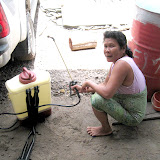 17-18 September 2012: visit to smallholders (1)
17-18 September 2012: visit to smallholders (1)
We visited 6 smallholders over two days, most of which reside in longhouses near Company K. Our interviews with the smallholders were conducted to comprehend how they prepare their land, cultivate, harvest and sell oil palm. My preceding study showed that the greenhouse gas emissions associated with oil palm production could be minimized by both maximizing yields in a land converted from lands with low carbon and minimizing the use of nitrogen fertilizers. In the interview, we tried to collect every piece of information that was related to greenhouse gases, e.g. gasoline consumption for use of chainsaws in land clearing, spraying equipment in applying weedicide, etc.
The interview revealed that the oil palm yield in smallholdings is significantly smaller than that of plantations although nitrogen fertilizers applied are similar in quantity. Oil palm is cultivated in plantations under strict fertilizer and pest control schemes whereas smallholders cultivate oil palm within a short time and budget with limited knowledge. As seen in the following photos, the oil palm trees and fields were not well-maintained compared with plantations. The leaves of oil palm trees turned yellow with black spots. The fields were covered with weeds. These might be some of the reasons for the low oil palm yields in smallholdings.
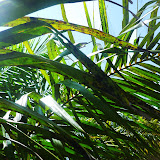
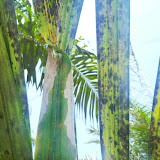
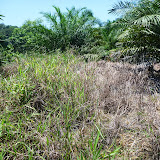 19 September 2012: visit to smallholders (2)
19 September 2012: visit to smallholders (2)
Company K provides several longhouses with a social scheme as part of the RSPO system to support smallholders’ oil palm cultivation. We visited two longhouses under the company’s scheme and conducted interviews regarding their cultivations. As the smallholders in these longhouses took the company’s training courses to learn how to cultivate oil palm cultivation, their oil palm fields looked well-managed. As some of them depend solely on oil palm cultivation for their entire income, they spend sufficient time on its management. The condition of the oil palm trees of these smallholders appears to be almost the same as that of plantations.
20 September 2012: visit to Company K
Although we have gathered necessary data associated with oil palm cultivation in past visits, we still need some more data to complete GHG emissions accounting, for example, how much fuel was consumed in land clearance before planting oil palm. However, we have obtained only a few data because the information before the company obtained RSPO certification was not well documented and prepared. We also visited the associate manager of an oil palm processing mill. We discussed technical and economic issues in recovering methane from POME (Palm Oil Mill Effluent) as well as problems of RSPO certified oil.
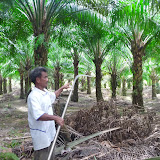 Summary
Summary
In the field survey, we collected all the necessary information to estimate financial flow and GHG emissions from both plantations and smallholdings. The important outcome from the survey was smallholders’ information on oil palm cultivation. Although some are still not available, those could be presumed from other data sources. We are now analyzing the data obtained in the visits and writing a paper to be submitted to a scientific journal soon.